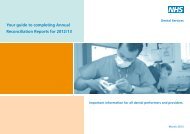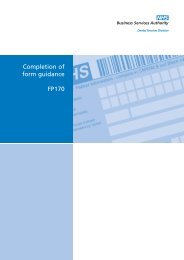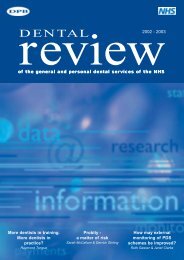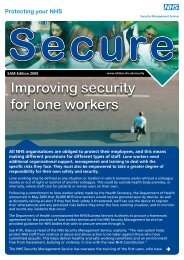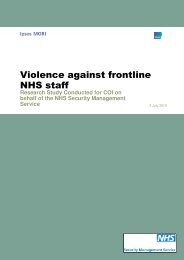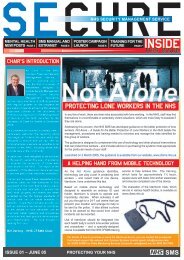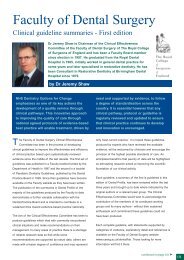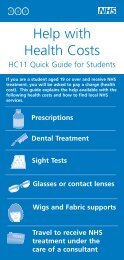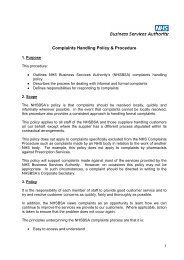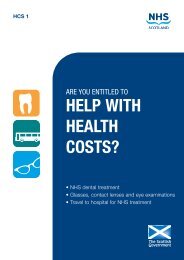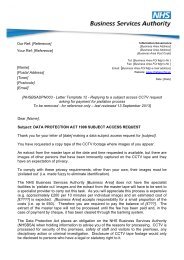Working in partnership: Getting the best from inspection, audit ...
Working in partnership: Getting the best from inspection, audit ...
Working in partnership: Getting the best from inspection, audit ...
- No tags were found...
Create successful ePaper yourself
Turn your PDF publications into a flip-book with our unique Google optimized e-Paper software.
Objective sixInspections are targeted and proportionatePractice 6.1Targeted to capacity and performanceIn develop<strong>in</strong>g work programmes, <strong>in</strong>spect<strong>in</strong>g bodies take <strong>in</strong>to account <strong>the</strong>nature, size and performance of <strong>the</strong> body be<strong>in</strong>g <strong>in</strong>spected. If necessary, <strong>the</strong>yvary <strong>the</strong>ir requirements.Practice 6.2Weighted to riskInspect<strong>in</strong>g bodies develop an assurance framework that helps <strong>the</strong>m to plan <strong>the</strong>iractivities accord<strong>in</strong>g to <strong>the</strong> level of risk to <strong>the</strong> service and/or o<strong>the</strong>r risks. Methodsare developed to def<strong>in</strong>e and grade risks. Consideration is given to reduc<strong>in</strong>grequirements <strong>in</strong> areas that carry lower risk to patients, carers, o<strong>the</strong>r people whouse services or staff, or where recent <strong>in</strong>spections have reported favourably.Practice 6.3Earned autonomyEarned autonomy is where good performers receive less regulation. Optionsfor earned autonomy are considered where <strong>the</strong> results of <strong>in</strong>spections justify<strong>the</strong>se. They may <strong>in</strong>clude regular <strong>in</strong>tervals between <strong>in</strong>spections, less frequentor less <strong>in</strong>tensive monitor<strong>in</strong>g and greater freedoms. In reach<strong>in</strong>g suchdecisions, <strong>the</strong> degree of risk is assessed and account is taken of <strong>the</strong>cont<strong>in</strong>u<strong>in</strong>g need to identify and learn <strong>from</strong> <strong>best</strong> practice, to safeguard <strong>the</strong>public and to support effective <strong>the</strong>matic studies.Practice 6.4Range of mechanisms and levels of actionInspect<strong>in</strong>g bodies develop a range of activities and levels of action capable ofrespond<strong>in</strong>g to <strong>the</strong> differ<strong>in</strong>g requirements of a range of organisations. Inspectorsuse <strong>the</strong> m<strong>in</strong>imum response that is necessary <strong>in</strong> <strong>the</strong> circumstances. On site<strong>in</strong>spection is only one option. O<strong>the</strong>rs <strong>in</strong>clude remote <strong>in</strong>formation analysis andself assessment.Practice 6.5Assess<strong>in</strong>g <strong>the</strong> impact of <strong>in</strong>spect<strong>in</strong>g bodies’ policiesInspect<strong>in</strong>g bodies assess and, where appropriate, seek to anticipate <strong>the</strong>impact of <strong>the</strong>ir policies and/or new <strong>in</strong>itiatives on those <strong>the</strong>y <strong>in</strong>spect. Whererelevant, significant changes would usually be subject to a regulatory impactassessment 6 .16 Concordat Gett<strong>in</strong>g <strong>the</strong> <strong>best</strong> <strong>from</strong> <strong>in</strong>spection, <strong>audit</strong>, review and regulation of health and social care May 2006



